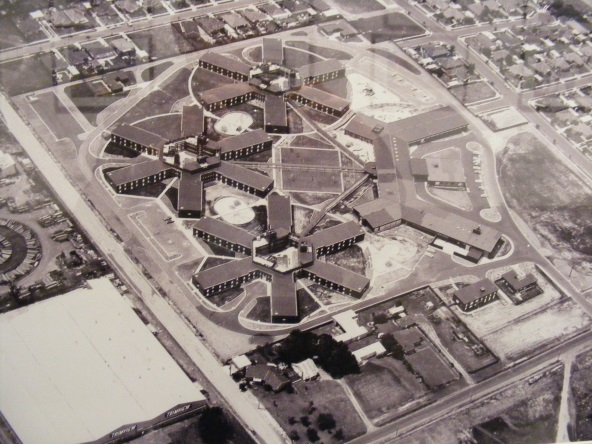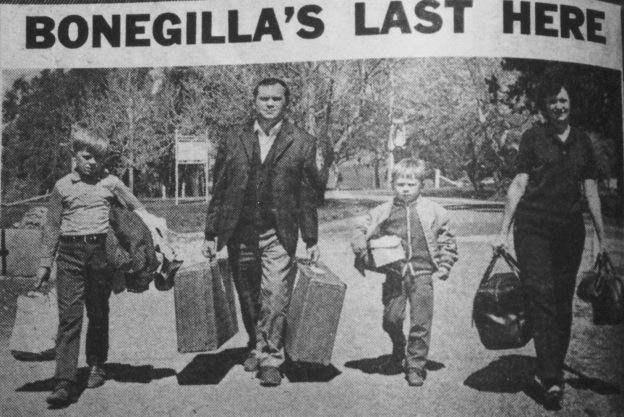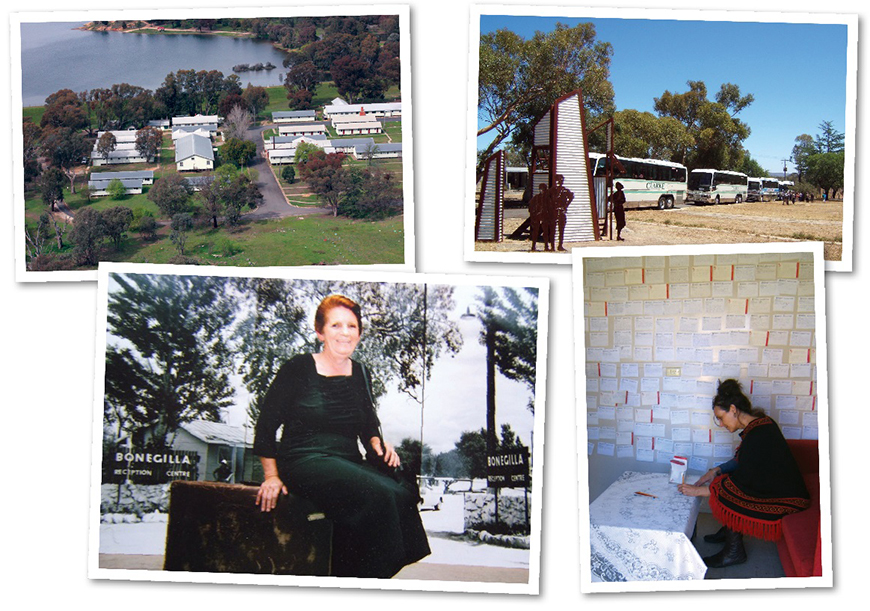Bonegilla’s end
The ABC program ‘This Day Tonight’ was like today’s ‘7.30 Report’. The program team interviewed Mario Giselli in November 1971 to try to make sense of what the Bonegilla Migrant Centre had been about. The documentary opens with Giselli enjoying a meal with friends. He recalls his journey to and arrival at Bonegilla. He revisits the hall where the director met new arrivals and welcomed them to Australia and to Bonegilla. He wanders between the huts, recalling some of the difficulties of communal living and the loss of privacy involved. He sits to a meal and recalls his first encounters with Australian cuisine. He sees children from the school playing, while a voice over declares that over 12,000 children were helped to learn English in this place.
- How does the film convey the idea that Mario Giselli was a successful migrant?
- What does the film praise Bonegilla for doing?
- How does the film acknowledge that the migrant experience was not always a pleasant one?
- How did those being filmed respond to the cameraman’s presence?
-
Why did Bonegilla close in 1971? chevron_right
 By the end of the 1960s economic conditions in Australia and in Europe had improved. A better style of temporary accommodation was prepared of new arrivals in specially built migrant centres close to employment opportunities in cities, like that the Enterprise Hostel in Springvale, Victoria. Opened it 1970, it and other new hostels offered a ‘non-institutional’ atmosphere and privacy for families.
By the end of the 1960s economic conditions in Australia and in Europe had improved. A better style of temporary accommodation was prepared of new arrivals in specially built migrant centres close to employment opportunities in cities, like that the Enterprise Hostel in Springvale, Victoria. Opened it 1970, it and other new hostels offered a ‘non-institutional’ atmosphere and privacy for families.It was no longer convenient or economically prudent to keep Bonegilla open.
 When the last two migrant accommodation centres at Benalla and at Bonegilla closed in 1967 and 1971 the Ministers of Immigration, Billy Snedden, and, then, his successor Philip Lynch, declared ‘the end of a phase in the post-war immigration programme’. The lightly dusted-down defence force facilities at Benalla and Bonegilla had served their purpose in providing ‘nothing more than temporary accommodation at a time when Government was faced with an acute shortage of housing and building materials’.
When the last two migrant accommodation centres at Benalla and at Bonegilla closed in 1967 and 1971 the Ministers of Immigration, Billy Snedden, and, then, his successor Philip Lynch, declared ‘the end of a phase in the post-war immigration programme’. The lightly dusted-down defence force facilities at Benalla and Bonegilla had served their purpose in providing ‘nothing more than temporary accommodation at a time when Government was faced with an acute shortage of housing and building materials’. -
Why has Bonegilla become a heritage place? chevron_right

In May 1990, the remnant Block 19 of the 24 block centre was put on the Register of the National Estate. As a registered place of ‘special value to future generations’, it was protected from demolition or major change. In 2002, it was put on the Victorian Heritage Register and prepared as a ‘commemorative place and tourism venue’. In 2007, it was included on the National Heritage List as a place of ‘outstanding heritage value to the nation’. A two-metre-plaque declared the former reception centre ‘a symbol of post-war migration, which transformed Australia’s economy, society and culture’.Heritage Victoria listed Block 19 because ‘Bonegilla was the first, the last and the largest migrant reception centre in a system of camps in all States’ and it was an important army camp:
Block 19 has the capacity to demonstrate to all Australians the physical environment faced by the hundreds of thousands of migrants who were accommodated in the former army camps utilised as Reception and Training Centres. With its simple and spartan military buildings, its grid layout and its typical plantings of native and exotic trees, it is crucially significant as the last surviving touchstone of the immigrant experience at Bonegilla.
The Block 19 Precinct is historically significant as a now rare remnant of the expansionist phase of defence building activity which took place at the commencement of the Second World War. It was one of 24 separate accommodation blocks which formed the Bonegilla Army Camp and the camp itself was part of a wider network of camps which included Enoggera in Queensland, Holsworthy in New South Wales, Puckapunyal in Victoria, Northam in Western Australia and Woodside in South Australia. Block 19 is also significant as a remnant of the logistical and organisational expansion of the Army during the Vietnam War.
In 2007 the Australian Heritage Council determined that:
Bonegilla holds powerful connections for many people in Australia. It forms an important part of Australia's recent collective memory and symbolises the central role of Bonegilla in the peopling of Australia with immigrants in the post-war years. It is estimated that there are over 1.5 million descendants of migrants who spent time at Bonegilla. It represents the role of Australia as the 'host' nation…. For the migrants who spent time at the migrant reception and training centre and their descendants, Block 19, Bonegilla is important as their first home in Australia. For the broader Australian community, Bonegilla represents the arrival of the post-war migration which has transformed the nation economically, socially and culturally.
Since then Bonegilla has become a personal/family memory place of migration experiences.
Visitors have responded to Bonegilla as a place in their own words. They give stories of the joys, sorrows and trials of migration. They tell of different kinds of resilience and resistance.
- Learn more about Bonegilla Migrant Camp - Block 19
- Learn more about National Heritage Places - Bonegilla Migrant Camp - Block 19
- Learn more about Block 19 - Statement of Significance
